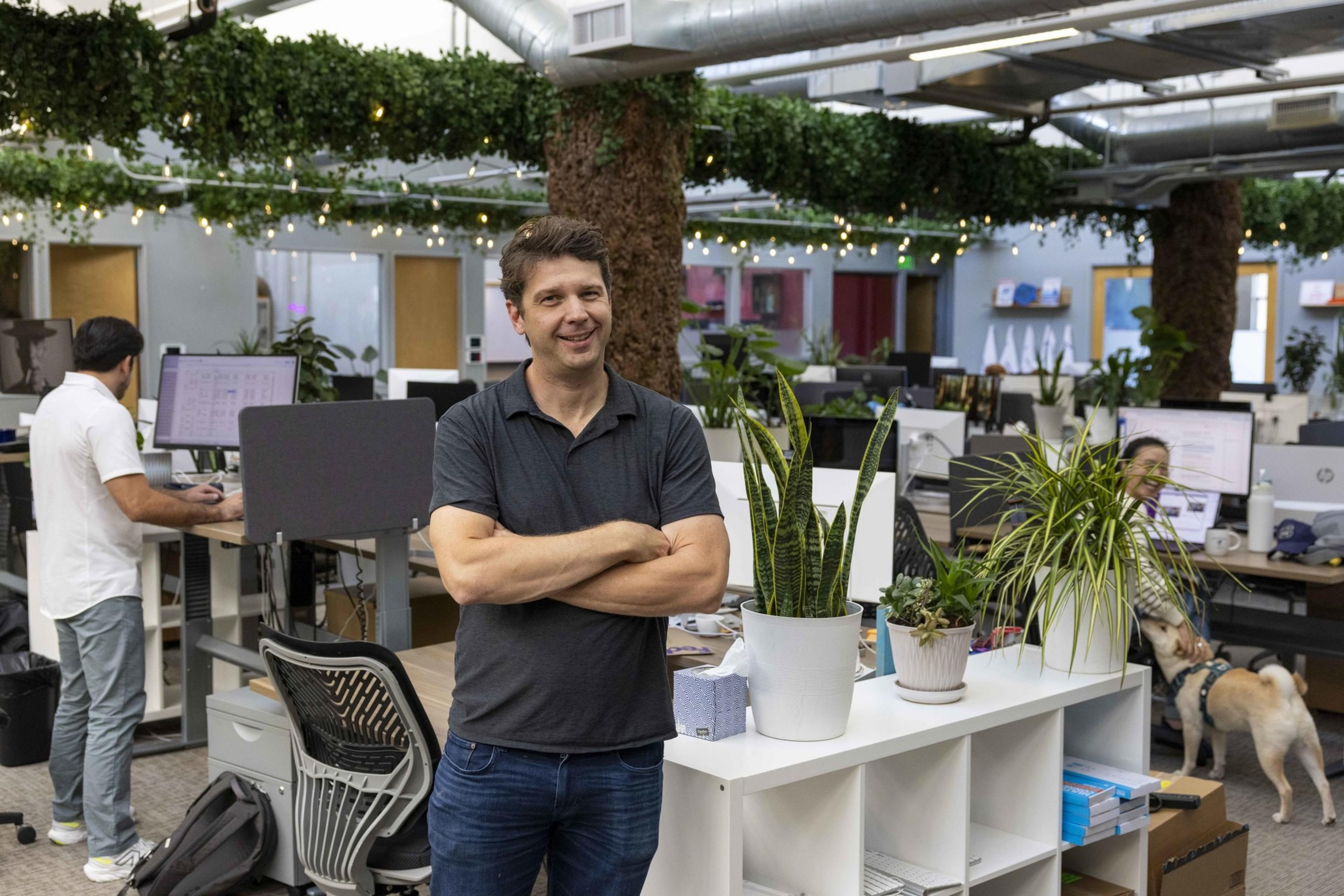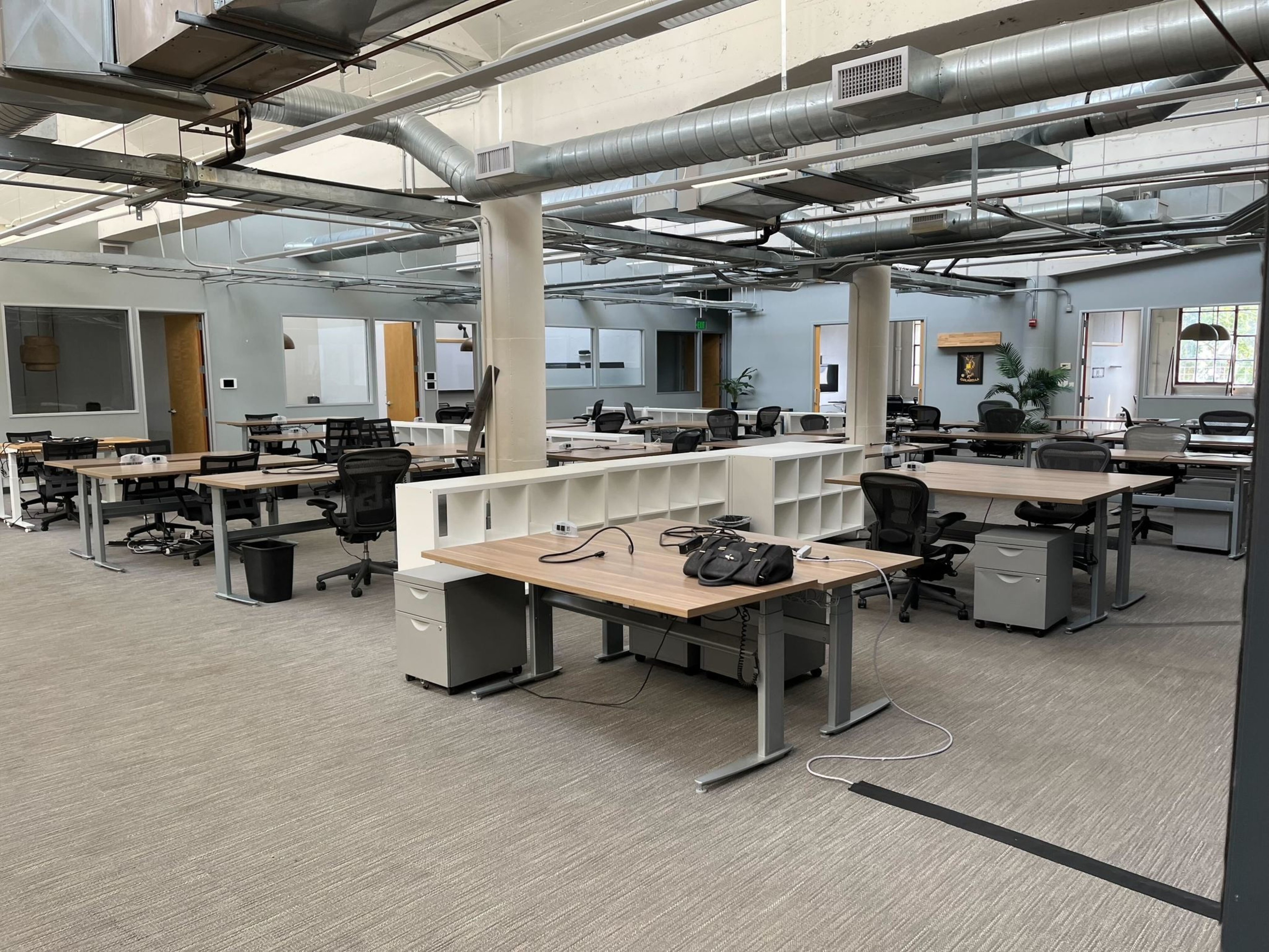For nearly a decade, the 3,500-square-foot office in Hayes Valley was all Andrew Mason really needed. He leased the space in 2015 fresh off his dismissal as CEO of Groupon (opens in new tab), the company he founded and steered toward a multibillion-dollar valuation, and turned it into a creative playhouse, the antithesis to everything he had experienced in corporate America.
On the first floor of the low-slung brick building at 385 Grove St. — which was adorned with mannequins of dead presidents (opens in new tab) spotlighted in John Oliver’s “Last Week Tonight,” antique deer antlers, and oil paintings of a handful of his “most interesting” colleagues — he founded Detour, an app offering off-the-beaten-path audio tours of cities that was purchased by Bose (opens in new tab) in 2018.
After the acquisition, Mason and his team stayed in the space while developing an AI-driven product called Descript, which enables audio or video editing using written text rather than editing software. Despite getting early-stage funding from the likes of Andreessen Horowitz and Redpoint Ventures, the startup never found the need to expand its office footprint. Until now.

That’s due in part to OpenAI, which pumped $50 million into Descript (opens in new tab) the same month its public unveiling of ChatGPT upended the tech world. As a result, Descript’s headcount started to swell, and conference rooms became scarce.
“We’re in the awkward teen growth stage now,” Mason told The Standard of the startup’s most recent funding round. Like other emerging local AI companies, Descript needed more space and started shopping for bigger offices in a market with an abundance of options.
Eventually, the company landed on a third-floor suite in the Mission at 375 Alabama St., arguably the most aromatic street in the city, sandwiched between Tartine Manufactory and the Dandelion Chocolate factory. At 12,000 square feet, the new digs are nearly three times the size of Descript’s previous office, while the rent costs the same.
Descript’s experience shows an under-the-radar bright spot in San Francisco’s commercial real estate market. The Goldilocks zone of middle-segment office spaces is red-hot, particularly when compared to the deep chill of the big-box offices driving the city’s abysmal top-line vacancy numbers.
Of the 286 potential office tenants who have toured space within the last 12 months, at least two-thirds have requirements for between 3,000 and 20,000 square feet, according to data from real estate firm Avison Young.
“When the market is coming back, it has to start from somewhere,” said Louis Thibault, senior market intelligence analyst at Avison Young, adding that demand for smaller spaces outpaces other segments whenever the city starts a new real estate cycle.
Sizing up
Devin Kasper, head of office operations at Descript, said he toured five offices throughout the city in February with real estate firm JLL before settling on Alabama Street. The neighborhood feel and proximity to “Cerebral Valley” won over employees, as opposed to offerings in SoMa or downtown.
Kasper, a theatrical set designer prior to his career managing tech offices, personally remodeled the office after Descript signed its three-year lease in May. Over the course of six weeks, he moved each mannequin and piece of art from Grove Street while thrifting antiques at neighborhood shops to fill in the extra space.
Kasper even created an indoor parklet evocative of the ones his coworkers had grown fond of during their stint in Hayes Valley, rolling out AstroTurf and building wooden replicas of Victorians and trees made of papier-mâché and spray foam. Previously drab meeting rooms were transformed with colorful themes like “Forbidden Temple,” “Public Pool,” and “Spring Break.”
Gallery of 6 photos
the slideshow
“In my head, I wanted it to be a love letter to both Hayes Valley and San Francisco,” Kasper said. Since Descript makes in-person attendance optional for its 160-plus employees, the new offices needed to be a fun and welcoming place where people would want to come, rather than feeling forced, he said. Hence, the karaoke stage tucked away in a corner.
“This is by far the most impressive thing anyone has ever done in the history of this company,” Mason quipped with his trademark offbeat sense of humor (opens in new tab). “I guess this [bigger office] puts us right at the cutoff for a kibbutz.”
While the commercial real estate market in San Francisco has been bleak since the pandemic, demand for starter offices, like Descript’s former headquarters, is as high as it’s ever been, said Colin Yasukochi, executive director of CBRE’s Tech Insights Center.
Yasukochi said CBRE’s tracking data show that offices under 10,000 square feet accounted for 24.4% of all leases signed so far this year. The last time the segment had that high of a market share was in 2011.
Before Descript was forced into graduating to its new office, Mason wanted to hold off on the change for as long as he could.
“This isn’t my first rodeo, and I didn’t want to repeat the same mistakes,” he said, sitting at his desk in the middle of the open floor plan. “I want us to be able to scale while holding onto the startup, individual-contributor mentality that got us here.”
That meant Kasper was tasked with preserving as much of the “haunted house vibes” from Grove Street as possible, rather than making the new office look like any other shiny tech space.
“If another company were to tour our space, I want them to feel like they’re in someone else’s skin,” Mason said. “That’s because only we would ever design our offices this way.”








